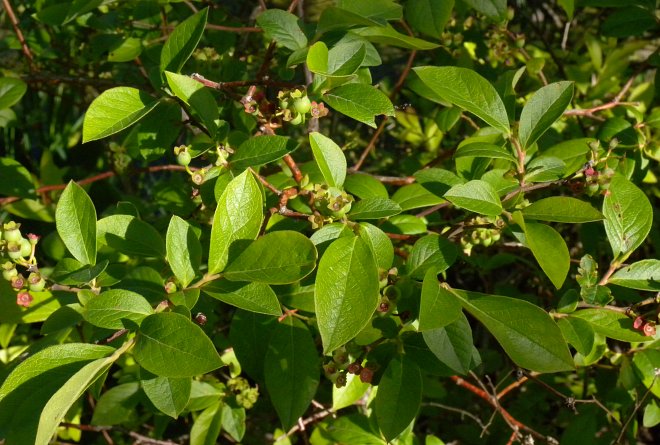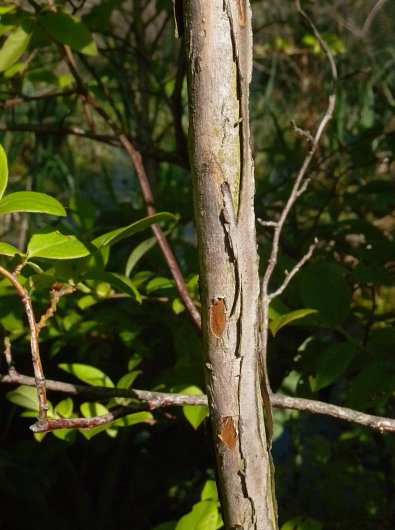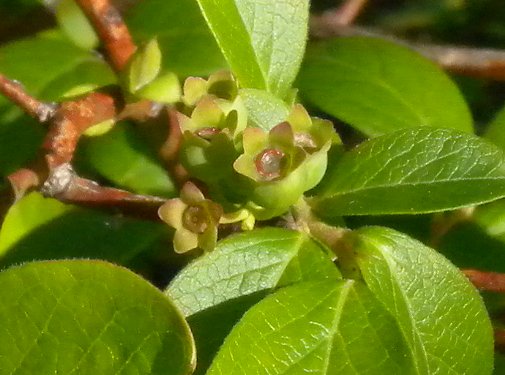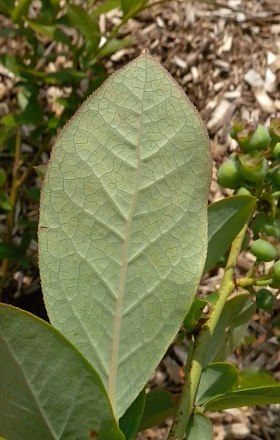
Small clusters of nodding flowers are produced from either lateral or terminal shoots, often in succession along individual branches. These flowers are about 1/3" (8 mm.) in length. Each flower consists of a tubular corolla, a short calyx, 10 included stamens, and a pistil with a single style. The corolla is white to pinkish white with 5 short broad teeth along its outer rim that are recurved. The calyx is light green and glabrous with 5 short broad teeth. The calyx is much shorter than the corolla. The pedicels of the flowers are light green to red and either glabrous or finely short-pubescent; they are up to ½" in length. The pedicel bases have conspicuous bracts that are light green to red, elliptic to ovate in shape, and glabrous. The blooming period occurs during late spring for about 2 weeks. Fertile flowers are replaced globoid berries that become about 1/3" (8 mm.) across at maturity. Mature berries are blue to blue-black with a white bloom; their interiors are sweet to sweet-tart and juicy, containing many tiny seeds. The root system is woody and spreading. This shrub spreads by reseeding itself. The deciduous leaves turn red during the autumn.

Cultivation: The preference is full or partial sun, wet to moist conditions, and an acidic soil that is peaty or sandy.
Range & Habitats: The native High-Bush Blueberry occurs in NE Illinois, where it is rare and state-listed as 'endangered' (see Distribution Map). Illinois lies along the western range-limit of this species. Habitats include forested bogs, tall shrub bogs, borders of lakes and streams, and sandy swamps. Trees that are associated with this shrub include the native Tamarack (Larix decidua), Red Maple (Acer rubrum), and Yellow Birch (Betula lutea). In Illinois, this shrub is found in high quality wetland habitats, where it benefits from relatively uncommon wildfires during periods of severe drought.

Faunal Associations: The flowers of this shrub are cross-pollinated by the Ruby-throated Hummingbird, honeybees, large carpenter bees, cuckoo bees (Nomada spp.), plasterer bees (Colletes spp.), and Andrenid bees (Andrena spp.); see DeGraaf (2002), Grundel et al. (2011), and Steury et al. (2009). The humminbird obtains nectar from the flowers, while the bees obtain nectar and/or pollen from them. Other insects feed destructively on the leaves, sap, fruits, and other parts of High-bush Blueberry and other blueberry shrubs (Vaccinium spp.). These insect feeders include the wood-boring larvae of long-horned beetles, leaf beetles, weevils, larvae of gall flies, aphids, spittlebugs, leafhoppers, mealybugs, scale insects, larvae of sawflies, larvae of many kinds of moths, and larvae of butterflies. The Insect Table provides a list of these species.

High-bush blueberry and other blueberry shrubs are also an important source of food to many mammals, especially the fruits. These mammals include the Gray Fox (fruits), American Red Fox (fruits), White-tailed Deer (foliage, twigs, fruits), Striped Skunk (fruits), Cottontail Rabbit (foliage, twigs, fruits), American Black Bear (fruits), Franklin's Ground Squirrel (fruits), Fox Squirrel (fruits), Least Chipmunk (fruits), Woodland Jumping Mouse (fruits, seeds), White-footed Mouse (fruits, seeds), and Deer Mouse (fruits, seeds). The Wood Turtle (Glyptemys insculpta) and Eastern Box Turtle (Terrapene carolina) also feed on the fruits (Martin et al., 1951/1961; Hamilton, 1941; Haugen, 1942; Schmidt, 1933; Beeman & Pelton, 1980; Mosnier et al., 2008; Ernst et al., 1994). Many kinds of birds also feed on the fruits, and they sometimes use these shrubs from protective cover and nesting habitat. These birds include sparrows, orioles, gamebirds, woodpeckers, thrushes, and many others (see Bird Table). The value of High-bush Blueberry and other blueberry shrubs to wildlife is high.

Photographic Location: A garden at the Arboretum of the University of Illinois in Urbana, Illinois, and a sandy swamp at Cowles Bog in NW Indiana.
Comments: Because High-Bush Blueberry is somewhat variable across its range, it has been divided by taxonomists into several species, subspecies, and varieties in the past. However, because these distinctions intergrade with each other in the field, they have been united into a single species, Vaccinium corymbosum. High-Bush Blueberry is a taller shrub than other species of blueberries that occur in Illinois and it prefers habitats that are more moist. Because of the size, abundance, and excellent flavor of its berries, this shrub is an important agricultural crop in many areas of the United States. For this purpose, many cultivars have been developed.